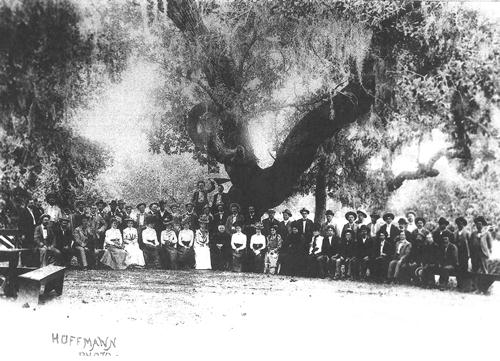
Our latest installment of the Famous Trees in Texas comes to us from the Spanish Missions period in Texas History. Throughout the 18th century, the Spanish established Catholic missions in Texas and, along with the missions, the towns of San Antonio, Goliad and Nagodoches. The Kings’ Highway (El Camino Real de los Tejas), which is also known as Old San Antonio Road, provided a link between Northwestern Louisiana and Mexico. Three separate routes of El Camino Real have been discovered and identified in New Braunfels. They are all a short distance from a series of artesian springs, known as Comal Springs. These springs feed into the Comal and Guadalupe Rivers.
Located just over five-hundred feet from Comal Springs, Founders’ Oak has stood as a sentry to centuries of travelers and settlers to the Guadalupe River region. From 1756-1758 Nuestra Senora De La Guadalupe (Our Lady of Guadalupe), A Spanish Mission, was located near the springs. It was run by two friars and under citizen guard. The Mission was home to four Spanish families and forty-one Native Americans. Due to raids by Native Americans, the Mission had to close in 1758.
Prince Carl of Solms-Braunfels was the Commissioner General of “The Society for the Protection of German Immigrants of Texas.” He came to the area in March of 1845 and signed a deed for two leagues of land. This area included Comal Springs and Founders’ Oak. As a result, New Braunfels was born.
The plentiful water from the Comal River and springs attracted settlers to New Braunfels, particularly industrialists who used the water for mills and cotton gins. Settlement was good and, by the 1850s, New Braunfels was the 4th largest city in Texas.
The Founders Oak is called as such because it has long played a part in the activities of the community’s founders. The first school teacher of the colony conducted group singing beneath the boughs of the tree. Abbe Domenech apparently offered mass under the tree in 1849. Each year after 1846, the citizens of New Braunfels gathered on July 4th to read the Declaration of Independence under the tree. They would rededicate themselves to the principles espoused in the document. Today, Founders’ Oak still stands and is the focal point of Landa Park.
For more information about Texas’ famous trees, please stay tuned to our blog. We try to do one article related to this topic once a month. We look forward to sharing more about Texas’ rich tree history with you.











